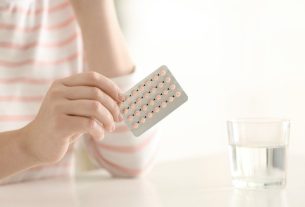Natural contraceptive methods are ways to avoid pregnancy, without the use of medications or devices such as condoms or diaphragms, for example. These methods are generally based on observations of a woman’s body and menstrual cycle to estimate the fertile period.
Although these methods have the advantages of being completely natural and not using hormones, they also have several disadvantages, especially because they are not completely effective and do not prevent the transmission of sexually transmitted infections.
Natural contraception requires not having sexual intercourse during a woman’s fertile period, requiring knowledge of the menstrual cycle, which can take up to 12 cycles. Currently, some cell phone applications, in which you can enter data on the menstrual cycle, mucus and temperature, are useful to help estimate the fertile period.

The main natural contraceptive methods are:
1. Calendar or table method
The calendar method, also known as the table or Ogino Knaus method, consists of avoiding sexual intercourse during the fertile period. To do this, the beginning and end of the fertile period must be calculated, based on the menstrual calendar.
The calendar method is based on the last 12 periods. Therefore, to calculate the fertile period you must subtract 18 days from the shortest cycle and 11 days from the longest cycle. For example, for a woman whose cycles vary from 28 days to 30 days, from day 10 (28 minus 18) to day 19 (30 minus 11) of each cycle, sexual intercourse should not be performed. The greater the variation in menstrual cycles, the longer the abstinence period.
Women with a regulated menstrual cycle have better results with this method, however, it is still an ineffective method for preventing pregnancy.
See how to use the table method.
2. Basal temperature method
The basal body temperature method is based on the variation in a woman’s body temperature, which may be higher during ovulation. This increase in temperature can reach up to 2ºC.
It’s a simple method, but it requires time and discipline as the woman has to check her temperature every morning, before getting up. To measure the temperature, you can use an analog or digital thermometer and the measurements must be written down to make a graph and thus observe the most fertile days, which are the days when the temperature is highest. On these days, women should avoid having sexual intercourse to avoid getting pregnant.
This method is not completely effective as factors such as stress, insomnia, illness and even the way in which temperature is measured can lead to an increase in body temperature.
3. Cervical Mucus Method
The cervical mucus method, also known as the Billings method, is based on observation of vaginal mucus. Soon after menstruation, the vagina becomes dry and during ovulation, crystalline mucus is produced, semi-transparent, odorless, and elastic, similar to egg white. The presence of this mucus indicates that the woman is fertile and should not have sexual intercourse from the first day the mucus appears and until three days after the mucus stops.
To check the presence of mucus, the woman must insert two fingers deep into the vagina and analyze the color and elasticity of the mucus.
The mucus method is not very effective, as many conditions, such as vaginal infections, can affect mucus production and consistency. See more about what cervical mucus looks like during ovulation.
4. Symptothermal method
The symptothermal method is a combination of the table, basal body temperature and cervical mucus methods. Furthermore, it takes into account common symptoms during the fertile period, such as pain and tenderness in the breasts or abdominal cramps, for example.
Because it combines three natural contraceptive methods, it may be a little more reliable, however, it is not completely effective and does not prevent the transmission of sexually transmitted infections.
5. Coitus interruptus method
The coitus interruptus method involves the man removing his penis from the vagina at the time of ejaculation, limiting the chances of the sperm reaching the egg. However, during foreplay and even before ejaculating, the penis releases mucus that may contain sperm and even without ejaculating into the vagina, pregnancy can occur. Furthermore, it is necessary for the man to have self-control and know the exact moment he is about to ejaculate. Furthermore, the woman needs a lot of trust in her partner to use the coitus interruptus method.
This method has very low effectiveness, in addition to interrupting the couple’s intimate moment. Find out more about coitus interruptus.
6. Ovulation test
The ovulation test is performed with kits that measure the amount of luteinizing hormone in the urine. This hormone is responsible for egg maturation and increases 20 to 48 hours before ovulation. Thus, the test indicates when a woman enters her fertile period and should avoid sexual intercourse to reduce the chances of becoming pregnant.
The ovulation test can be purchased at pharmacies and is easy to use. See how to take the ovulation test.
7. Lactational amenorrhea method
The lactational amenorrhea method is based on the idea that a woman cannot become pregnant while she is breastfeeding. This period is also marked by the absence of menstruation, called amenorrhea.
During this phase, the woman is not fertile, and generally ovulates again 10 to 12 weeks after giving birth.
The lactational amenorrhea method is not a good contraceptive method, as a woman can ovulate and not realize it, mainly because there is no prediction of when menstruation will return to normal. Furthermore, it is not recommended for women who are not breastfeeding.

Sign up for our newsletter and stay up to date with exclusive news
that can transform your routine!



